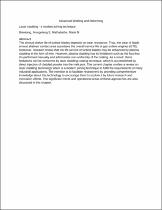JavaScript is disabled for your browser. Some features of this site may not work without it.
- ResearchSpace
- →
- Research Publications/Outputs
- →
- Journal Articles
- →
- View Item
| dc.contributor.author |
Bolokang, Amogelang S

|
|
| dc.contributor.author |
Mathabathe, Maria N

|
|
| dc.date.accessioned | 2023-03-15T10:47:31Z | |
| dc.date.available | 2023-03-15T10:47:31Z | |
| dc.date.issued | 2021-04 | |
| dc.identifier.citation | Bolokang, A.S. & Mathabathe, M.N. 2021. Laser cladding - a modern joining technique. In <i>Gupta, K and Paulo Davim, J. Advanced Welding and Deforming</i>. S.l.: Elsevier. http://hdl.handle.net/10204/12668 . | en_ZA |
| dc.identifier.isbn | 978-0-12-822049-8 | |
| dc.identifier.uri | 978-0-12-822050-4 | |
| dc.identifier.uri | http://dx.doi.org/10.1016/B978-0-12-822049-8.00011-6 | |
| dc.identifier.uri | https://doi.org/10.1016/C2018-0-00909-3 | |
| dc.identifier.uri | http://hdl.handle.net/10204/12668 | |
| dc.description.abstract | The shroud shelve life of turbine blades depends on wear resistance. Thus, the wear of blade shroud shelves’ contact area ascertains the overall service life of gas turbine engines (GTE). Moreover, research shows that the life service of turbine blades may be enhanced by plasma cladding in the form of wire. However, plasma cladding has its limitations such as the fact that it’s performed manually and administers non-uniformity of the coating. As a result, these limitations can be overcome by laser cladding coating technique, which is accomplished by direct injection of cladded powder into the melt pool. The current chapter confers a review on laser cladding technology which is a modern joining technique to fulfill the requirements of many industrial applications. The intention is to facilitate researchers by providing comprehensive knowledge about this technology to encourage them to explore it by future research and innovation efforts. The significant merits and operational areas of these approaches are also discussed in this chapter. | en_US |
| dc.format | Abstract | en_US |
| dc.language.iso | en | en_US |
| dc.publisher | Elsevier | en_US |
| dc.relation.uri | https://www.sciencedirect.com/science/article/pii/B9780128220498000116?via%3Dihub | en_US |
| dc.source | Gupta, K and Paulo Davim, J. Advanced Welding and Deforming | en_US |
| dc.subject | Coating | en_US |
| dc.subject | Deforming | en_US |
| dc.subject | Laser cladding | en_US |
| dc.subject | Service life | en_US |
| dc.subject | Welding | en_US |
| dc.subject | Turbine blades | en_US |
| dc.title | Laser cladding - a modern joining technique | en_US |
| dc.type | Book Chapter | en_US |
| dc.description.pages | 291-319 | en_US |
| dc.description.placeofpublication | Amsterdam | en_US |
| dc.description.note | Due to copyright restrictions, the attached PDF file only contains the abstract of the full text item. For access to the full text item, please consult the publisher's website: https://doi.org/10.1016/C2018-0-00909-3 | en_US |
| dc.description.cluster | Manufacturing | en_US |
| dc.description.impactarea | Powder Metallurgy Technologies | en_US |
| dc.description.impactarea | Advanced Casting Technologies | en_US |
| dc.identifier.apacitation | Bolokang, A. S., & Mathabathe, M. N. (2021). Laser cladding - a modern joining technique., <i>Gupta, K and Paulo Davim, J. Advanced Welding and Deforming</i> Elsevier. http://hdl.handle.net/10204/12668 | en_ZA |
| dc.identifier.chicagocitation | Bolokang, Amogelang S, and Maria N Mathabathe. "Laser cladding - a modern joining technique" In <i>GUPTA, K AND PAULO DAVIM, J. ADVANCED WELDING AND DEFORMING</i>, n.p.: Elsevier. 2021. http://hdl.handle.net/10204/12668. | en_ZA |
| dc.identifier.vancouvercitation | Bolokang AS, Mathabathe MN. Laser cladding - a modern joining technique.. Gupta, K and Paulo Davim, J. Advanced Welding and Deforming. [place unknown]: Elsevier; 2021. [cited yyyy month dd]. http://hdl.handle.net/10204/12668. | en_ZA |
| dc.identifier.ris | TY - Book Chapter AU - Bolokang, Amogelang S AU - Mathabathe, Maria N AB - The shroud shelve life of turbine blades depends on wear resistance. Thus, the wear of blade shroud shelves’ contact area ascertains the overall service life of gas turbine engines (GTE). Moreover, research shows that the life service of turbine blades may be enhanced by plasma cladding in the form of wire. However, plasma cladding has its limitations such as the fact that it’s performed manually and administers non-uniformity of the coating. As a result, these limitations can be overcome by laser cladding coating technique, which is accomplished by direct injection of cladded powder into the melt pool. The current chapter confers a review on laser cladding technology which is a modern joining technique to fulfill the requirements of many industrial applications. The intention is to facilitate researchers by providing comprehensive knowledge about this technology to encourage them to explore it by future research and innovation efforts. The significant merits and operational areas of these approaches are also discussed in this chapter. DA - 2021-04 DB - ResearchSpace DO - 10.1016/B978-0-12-822049-8.00011-6 DP - CSIR J1 - Gupta, K and Paulo Davim, J. Advanced Welding and Deforming KW - Coating KW - Deforming KW - Laser cladding KW - Service life KW - Welding KW - Turbine blades LK - https://researchspace.csir.co.za PY - 2021 SM - 978-0-12-822049-8 T1 - Laser cladding - a modern joining technique TI - Laser cladding - a modern joining technique UR - http://hdl.handle.net/10204/12668 ER - | en_ZA |
| dc.identifier.worklist | 24501 | en_US |






